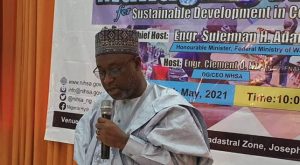The Minister of Water Resources, Mr Suleiman Adamu, has warned that 32 states and 233 Local Government Areas, including the Federal Capital Territory (FCT), are at a high risk of flooding in Nigeria.

Adamu made the disclosure on Thursday, May 12, at the presentation of the 2022 Annual Flood Outlook (AFO) of the Nigeria Hydrological Services Agency in Abuja.
The outlook, themed “Flood management and food Security”, is targeted towards flood early warning, and forecasting in order to minimise the adverse effects of flood on lives.
“Some 233 local Government Areas in 32 states of the Federation and the FCT fall within the highly probable risk areas, while 212 Local government areas in 35 states, including FCT, fall within the moderately flood risk areas.
“Adamawa, Abia, Akwa Ibom, Anambra, Bauchi and Bayelsa fall within the highly flood risk areas,” he said.
Other states, according to 2022 AFO highly probable risk areas, are Benue, Cross Rivers, Delta, Ebonyi, Ekiti, Edo, Gombe, Imo, Jigawa, Kaduna and Kano.
“The level of floods in the highly probable flood risk areas between the months of April and November is expected to be high in terms of impacts on population, agriculture, livelihood, livestock, infastructure and the environment.”
He called on all stakeholders to consider the flood forecasts, flood early warnings and information being issued by NIHSA in its AFO weekly and monthly alerts to reduce flooding incidences in the country.
Mr Clement Nze, Director General, Nigeria Hydrological Services Agency (NIHSA), said while delivering his address that the overall objective of the event is to sensitise planners, decision and policy makers, farmers, stakeholders and the public.
He stressed the need to take on preventive measures to improve on safety and reduce damages to lives and properties.
“We believe that this will go a long way in creating awareness, enhancing planning and promoting sustainable socio-economic development through effective flood risk mitigation and management,” Nze stated.
He added that the focus is rather on preventive and mitigation of possible flood disasters through increasing its visibility on the part of the populace and encouraging them to comply with environmental guidelines.
By Patricia Amogu
